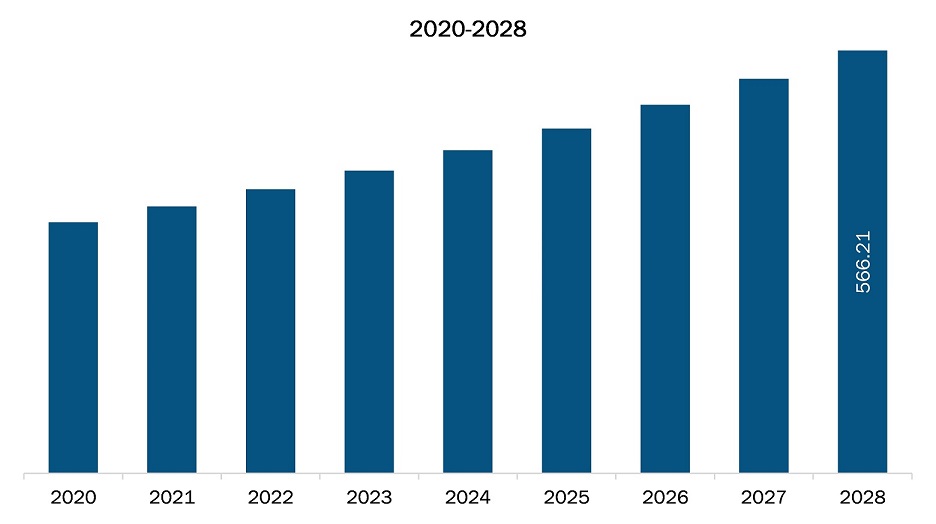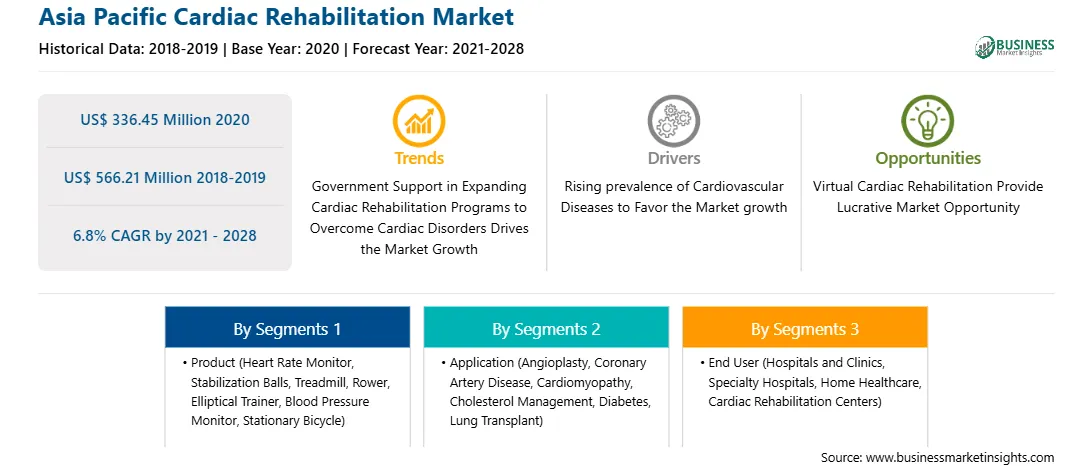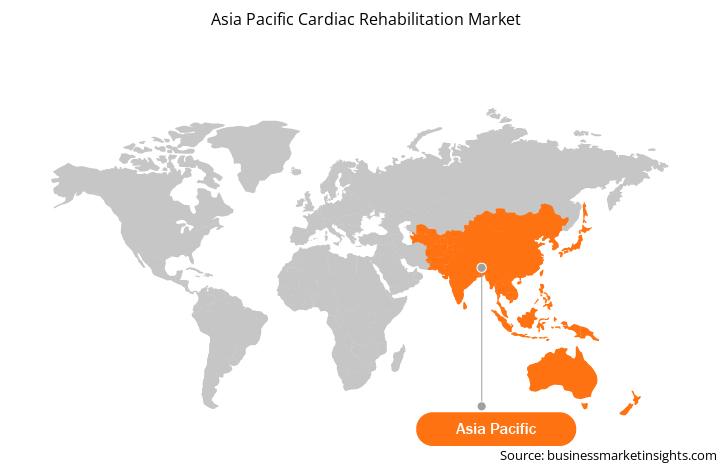Cardiac rehabilitation devices are used by patients suffering from heart diseases. These rehabilitation devices aid the patients in reducing the danger of heart attacks and heart diseases. Counseling sessions, psychosocial interventions, physical activity counseling, nutritional counseling, hypertension, diabetes & weight management, and exercise are some of the activities that aid in monitoring a patient’s disease.

Strategic insights for the Asia Pacific Cardiac Rehabilitation provides data-driven analysis of the industry landscape, including current trends, key players, and regional nuances. These insights offer actionable recommendations, enabling readers to differentiate themselves from competitors by identifying untapped segments or developing unique value propositions. Leveraging data analytics, these insights help industry players anticipate the market shifts, whether investors, manufacturers, or other stakeholders. A future-oriented perspective is essential, helping stakeholders anticipate market shifts and position themselves for long-term success in this dynamic region. Ultimately, effective strategic insights empower readers to make informed decisions that drive profitability and achieve their business objectives within the market.

| Report Attribute | Details |
|---|---|
| Market size in 2020 | US$ 336.45 Million |
| Market Size by 2028 | US$ 566.21 Million |
| CAGR (2021 - 2028) | 6.8% |
| Historical Data | 2018-2019 |
| Forecast period | 2021-2028 |
| Segments Covered |
By Product
|
| Regions and Countries Covered | Asia-Pacific
|
| Market leaders and key company profiles |
|
The geographic scope of the Asia Pacific Cardiac Rehabilitation refers to the specific areas in which a business operates and competes. Understanding local distinctions, such as diverse consumer preferences (e.g., demand for specific plug types or battery backup durations), varying economic conditions, and regulatory environments, is crucial for tailoring strategies to specific markets. Businesses can expand their reach by identifying underserved areas or adapting their offerings to meet local demands. A clear market focus allows for more effective resource allocation, targeted marketing campaigns, and better positioning against local competitors, ultimately driving growth in those targeted areas.

The Asia Pacific cardiac rehabilitation market is expected to reach US$ 566.21 million by 2028 from US$ 336.45 million in 2020; it is estimated to grow at a CAGR of 6.8% from 2021 to 2028. The growth of the market is attributed to some key driving factors such as rise in technologically advanced cardiac rehabilitation products and supportive government initiatives for cardiac rehabilitation. However, the high cost of the cardiac rehabilitation equipment is expected to obstruct the growth of the market to a certain extent during the forecast years.
CR is an evidence-based, multidisciplinary intervention conferred to enhance health consequences and quality of life when used as secondary prevention. Several government initiatives are considered to have a high impact on the market. Increasing awareness regarding the CR, growing referral of eligible patients, and reducing system and limitations of the patient cooperation in promoting the enrolment, referral, and participation rates in CR programs. Several manufacturers are working on advanced cardiac rehabilitation products. Effective partnerships across teams, government agencies, community resources, and independent-sector resources are central to providing the proper support in the right place for everyone. Such strategic initiatives are likely to offer growth opportunities to the market players to attain a significant position and grow in the market. Also, several manufacturers are working on advanced cardiac rehabilitation products. For instance, in April 2019, Royal Philips launched an ultrasonic system EPIQ CVx to offer excellent image clarity and sharpness, upgraded exam efficiencies, as well as more robust and reproducible quantification enabled by anatomical intelligence along with extraordinary processing power. Therefore, the adoption of technologically advanced cardiac rehabilitation products is likely to be a prevalent trend during the forecast period.
Countries in Asia-Pacific are expecting to witness massive challenges due to the growing COVID-19. Considering the economic operations and geographic conditions, the pandemic has affected medical tourism, manufacturers of medical equipment, and other problems posed by the shortage of healthcare infrastructure in Asia Pacific low-income countries. Due to rapidly changing risk of COVID-19 affected countries and always controlling outbreak trends, any additional health measures are likely to interfere with international travel and trade significantly. This is likely to have negative impact on the Asia Pacific cardiac rehabilitation market.
Based on product, the Asia Pacific cardiac rehabilitation market is segmented into heart rate monitor, stabilization balls, treadmill, rower, elliptical trainer, blood pressure monitor, stationary bicycle, and others. The treadmill segment held the largest share of the market in 2020, whereas the blood pressure monitor segment is anticipated to register the highest CAGR in the market during the forecast period.
Based on application, the Asia Pacific cardiac rehabilitation market is segmented into angioplasty, coronary artery disease, cardiomyopathy, cholesterol management, diabetes, and lung transplant. The angioplasty segment held the largest share of the market in 2020, and the coronary artery disease segment is anticipated to register the highest CAGR in the market during the forecast period.
Based on end user, the Asia Pacific cardiac rehabilitation market has been segmented into hospitals & clinics, specialty hospitals, home healthcare, cardiac rehabilitation centers, and others. The cardiac rehabilitation centers segment held the largest share of the market in 2020, and home healthcare segment is estimated to register the highest CAGR in the market during the forecast period.
A few of the primary and secondary sources associated with this report on the Asia Pacific cardiac rehabilitation market are the World Heart Federation (WHF), Australian Cardiovascular Health and Rehabilitation Association (ACRA) and World Health Organization (WHO).
The Asia Pacific Cardiac Rehabilitation Market is valued at US$ 336.45 Million in 2020, it is projected to reach US$ 566.21 Million by 2028.
As per our report Asia Pacific Cardiac Rehabilitation Market, the market size is valued at US$ 336.45 Million in 2020, projecting it to reach US$ 566.21 Million by 2028. This translates to a CAGR of approximately 6.8% during the forecast period.
The Asia Pacific Cardiac Rehabilitation Market report typically cover these key segments-
The historic period, base year, and forecast period can vary slightly depending on the specific market research report. However, for the Asia Pacific Cardiac Rehabilitation Market report:
The Asia Pacific Cardiac Rehabilitation Market is populated by several key players, each contributing to its growth and innovation. Some of the major players include:
The Asia Pacific Cardiac Rehabilitation Market report is valuable for diverse stakeholders, including:
Essentially, anyone involved in or considering involvement in the Asia Pacific Cardiac Rehabilitation Market value chain can benefit from the information contained in a comprehensive market report.